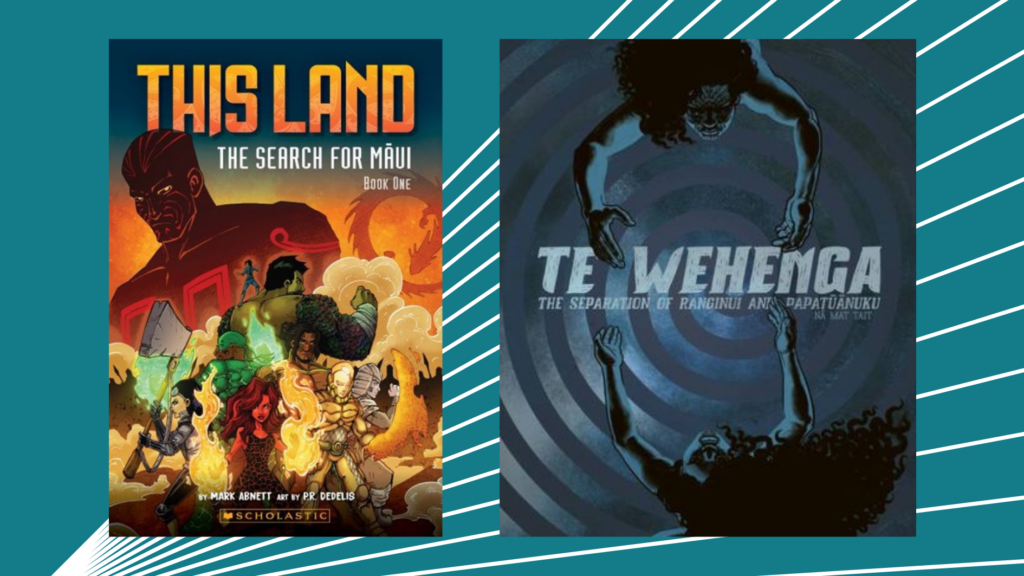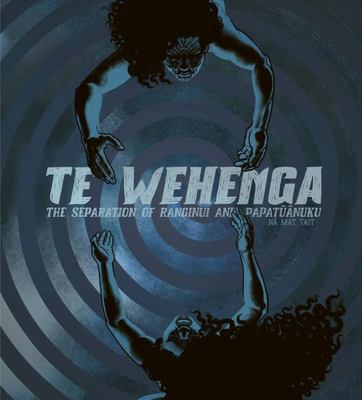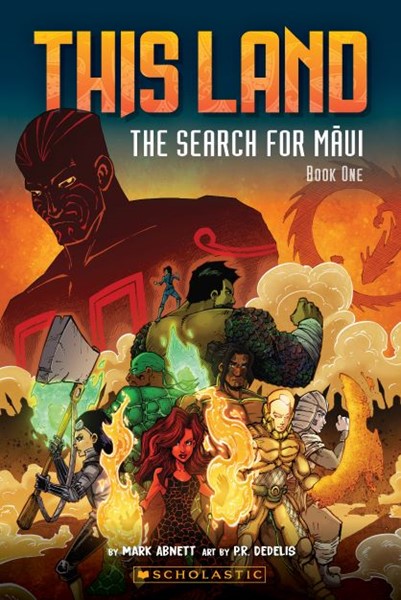Briar Lawry reviews two pukapuka inspired by pūrākau Māori—featuring a retelling of the separation of Ranginui and Papatūānuku and an action-packed adventure set in a post-apocalyptic world.

Stories inspired by pūrākau Māori are nothing new—it’s a growing and evolving space in Aotearoa’s book scene. Some creators take a retelling approach to their storytelling, while others pluck out people, places and ideas and turn them into something unexpected and different. Mat Tait’s Te Wehenga: The Separation of Ranginui and Papatūānuku is the former, and This Land: The Search for Māui is the latter.
Te Wehenga is not Mat Tait’s first rodeo when it comes to beautiful blue-toned books. It’s not even my first rodeo reviewing one of Mat Tait’s beautiful blue-toned books on The Sapling. I was enamoured with 2019’s The Adventures of Tupaia, where Tait’s illustrations accompanied Courtney Sina Meredith’s masterful writing. In Te Wehenga, the art and the words are all Mat’s, and the end result is an absolute treasure.
In Te Wehenga, the art and the words are all Mat’s, and the end result is an absolute treasure
Te Wehenga is an entirely bilingual retelling of the separation of Ranginui and Papatūānuku by their sons. The title itself literally means ‘The Separation.’ It is a story that anyone who has sat on a primary school mat in Aotearoa is familiar with, whether in Peter Gossage’s In the Beginning or some other iteration of the pūrākau. I won’t go into detail of the story itself because either a) you already know it or b) you don’t know it, and you should experience it for the first time reading the story yourself, not reading my plot summary.
Tait’s retelling leans into the inherent lyricism of te reo Māori and takes that feeling into the English phrasing. That’s not to say that it’s over-the-top or florid; on the contrary, it’s cleanly and carefully written in both languages. But there’s an oratory quality about it. Tait may be known as an illustrator, but he knows what he’s doing with language—English and Māori alike.
The art and design of the book are completely intertwined, with the words integrated into the artwork. The Māori text sits above or before the English text—in fact, before the story proper, Tait has included an extended acknowledgements section exclusively in Māori. ‘Mihi’ may generally be translatable as acknowledgements, but there is something of the fuller sense of the word mihi in this spread, with karakia and calls of appreciation to everyone from his publishers and teachers to Rangi and Papa themselves.
Tait’s retelling leans into the inherent lyricism of te reo Māori and takes that feeling into the English phrasing
I mentioned the blue tones of the book earlier. Limiting the majority of a book to variations of one colour might seem limiting, but Tait does incredible things with the colour scheme he has given himself to work with. He plays with light and dark—mostly dark—in a way that works in harmony with the storytelling.
The way the text is built into the artwork evokes the work of some big names in New Zealand art: Ralph Hotere, Peter Robinson, even Colin McCahon. If we look back, Tupaia’s artwork was part of an Auckland Museum exhibition, enhancing the artefacts on display. The spreads of Te Wehenga feel like they could be hung on gallery walls as the attractions themselves. It is beautiful, powerful work.
The way the text is built into the artwork evokes the work of some big names in New Zealand art: Ralph Hotere, Peter Robinson, even Colin McCahon
But yes, there are always details to pick apart in any book; Te Wehenga is no exception. It does feel that the aesthetic feel of the book has been prioritised over usability—the shadowy palette makes for very low-contrast lettering on the page. It can prove challenging to read—I had to focus more intently than expected at times, and I’m blessed with the most functioning retinas in my family. I spoke to someone who had also read the book and while they acknowledged its beauty, they said they did struggle with reading it.
Contrast aside, the production values are excellent. It’s a substantial but not unwieldy hardback, printed on luxurious paper stock. Allen & Unwin don’t do a huge amount of local publishing in the children’s space, but when they do, they put in care and effort, and it really does show.
So it’s a win for me—but make sure that you or your young reader has adequate lighting when soaking in the story.

Te Wehenga: The Separation of Ranginui and Papatūānuku
By Mat Tait
Published by Allen & Unwin
RRP: $37.99
This Land: The Search for Māui is the first in a pair of what will inevitably be called graphic novels in bookshops, but in comics parlance is really more like trade paperbacks, bringing together previously published single-issue comics. It’s very impressive looking—P.R. Dedelis’ illustrations are on a level with plenty of big-name series, and the colourist and letterers have some impressive credentials between them. There are maps (I love a map) and full-page frames that look like they could have hopped out of the pages of a Guardians of the Galaxy issue. That Guardians of the Galaxy band-of-misfits vibe comes through clearly in the book.
Before we even get into the book, though, it starts with a caveat: ‘This story is intended to be taken in a futuristic context, but with respect to what has come before’. I appreciate this gesture when reading it—it provided both context and clarity for what we were about to launch into. And launch into it we do. The post-apocalyptic continent we find ourselves on may not bear any resemblance to today’s motu, but the locations on the map provide a thread back to our day—with a few adjustments. As a born-and-raised resident of Tāmaki, I’m not quite sure how to feel about my city’s future being ‘Axeland’, but at least we’re better off than Waitomo becoming ‘Whitetomb.’
The post-apocalyptic continent we find ourselves on may not bear any resemblance to today’s motu, but the locations on the map provide a thread back to our day
The story kicks off in the year 52DT—52 years after the ‘Death of Technology’, which occurred around the same time as a catastrophe resulting in the destruction of the moon and resultant gravity changes and tectonic plate shifts. I always enjoy a dystopia that gives us a bit of context rather than just hand-waving the end of the known world in vague terms. There are new tribes, taniwha coming out of the works, mystical magic metal in the form of ‘mana steel.’ This new land of Te Riu-a-Māui centres te ao Māori much more than the Aotearoa of today. This is obviously not inherently a bad thing…but I will admit, knowing that the author and creator are Pākehā did make me start to wonder about whether the dreaded ‘A’ word was appropriate to pin to the book.
Whether or not this is appropriation is not my call to make. I may be the person whose opinion matters in this review, but as a Pākehā woman, I’m not the person whose opinion matters when it comes to issues of cultural impropriety. By virtue of having Māori collaborators credited (for ‘guidance’, ‘kowhaiwhai design’, ‘iwi design’ and ‘translation’), can it escape that potential accusation? It’s not for me to say. I’m Pākehā—I try to live up to the ideals of being tangata tiriti but ultimately I am not tangata whenua and these are not my traditions being used.
There were elements that frustrated me both as tangata tiriti and as an editor. There’s the macron inconsistency. ‘Taupo’ on one page, ‘Taupō’ on the next, just as one of many examples. Spelling, too: Kirikiriroa is ‘Kirikiroa’ on one page. ‘Wairua’ is ‘Wairuna’ on one map. I didn’t notice any misspellings of English words.
I will admit, knowing that the author and creator are Pākehā did make me start to wonder about whether the dreaded ‘A’ word was appropriate to pin to the book
Still, the things that I enjoyed about this book outweighed the things that gave me pause. It’s a rollicking adventure, with some fun characters and creative concepts. The main character has an unforgivably dire name (Is ‘Hell’na’ meant to be a ‘hell nah’ joke? A futuristic dropped syllable version of ‘Helena’?) but she’s a bit of a badass even if she does have a touch of the chosen one trope about her. It has the potential to be an awesome way to get superhero-mad kids reading stories with roots in Aotearoa. And I look forward to hearing what tamariki and rangatahi Māori think about it—the people whose opinions on this particular pukapuka matter most.

This Land: The Search for Māui
By Mark Abnett & P.R. Dedelis
Published by Scholastic NZ
RRP: $24.99

Briar Lawry is an English teacher and writer from Tāmaki Makaurau. She worked in bookshops for years, most notably Little Unity, and judged the NZCYA Awards in 2020. She was also one of the editors of The Sapling between 2019 and 2023.



